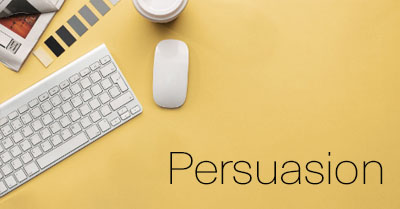Modes of Organization
Persuasive or Argumentative Mode of Organization
Persuasive Mode of Organization
Writers use the persuasive or argumentative mode of organization to present information in order to persuade readers to change their viewpoint or opinion, to do something, or to change their behavior.
Persuasion involves presenting arguments and evidence in support of a position. It also addresses counterarguments in order to strengthen the writer’s position.

fauxels | Pexels
Topics or ideas that call for the persuasive mode of organization include anything that you can argue or present evidence in order to change someone’s opinion, believe or point of view; to change change someone’s behavior; or to get someone to do something. These include, for example, you should (or must) “recycle to protect the environment,” “change your diet to be a healthier person,” “study a new language,” or “buy a house instead of renting.”
Types of Text Using the Persuasive or Argumentative Mode
The persuasive or argumentative mode is frequently used in advertisements, opinion pieces, editorials, and other texts aiming to persuade the reader.
Transition Words Used in the Persuasive or Argumentative Mode
Transitions commonly used in the persuasive or argumentative mode include:
- If… then, given that, it appears that, one could argue that: These words and expressions can be used to signal the writer’s position.
- Although, however, on the other hand: These words and expressions can be used to signal the introduction or rebuttal of a counterargument.
- It is obvious/evident that, clearly, it seems logical to think that, therefore, thus, as a result, consequently: These words and expressions can be used to signal the writer’s conclusion and reinforce the writer’s position.
Example persuasive or argumentative mode of organization
The following paragraph is written using the persuasive or argumentative mode of organization:
Having a dog is more than just having a friendly animal greet you when you come home. You should have a dog for the companionship, health outcomes, and improved mental health they will provide you and your family. Dogs are excellent companions. They are always ready to comfort and love their owners. In addition, dogs can help increase physical activity, as they require regular walks and playtime, which leads to improved overall health for their owners. Finally, owning a dog can have positive mental health benefits. Studies have shown that owning a dog can reduce stress and anxiety levels by providing a sense of purpose and routine. Dogs can also provide emotional support and help to combat feelings of loneliness or depression. The benefits owning a dog provides outweigh the time you need to put into caring for them. If you are at all interested in companionship and improved physical and mental health outcomes, you should get yourself a dog right away.
Note. The above paragraph is used for instructional purposes only. Search the topic for accurate information on it.
Note for Readers
When you read, it is important to identify the mode of organization as persuasive because it focuses your reading and improves comprehension.
Pay close attention to the argument the writer presents and how well the writer supports the argument. What evidence does the writer present to support claims? How does the writer show that the evidence presented is relevant and sufficient to reach the conclusion? What counterarguments does the writer present? How does the writer address counterarguments?
If you are taking notes, write down all parts of the logical argument, including the writer’s claims and how they lead to a logical conclusion.
Up Next: Chronological Order Mode
Continue the lesson to learn about the chronological or time order mode of organization.